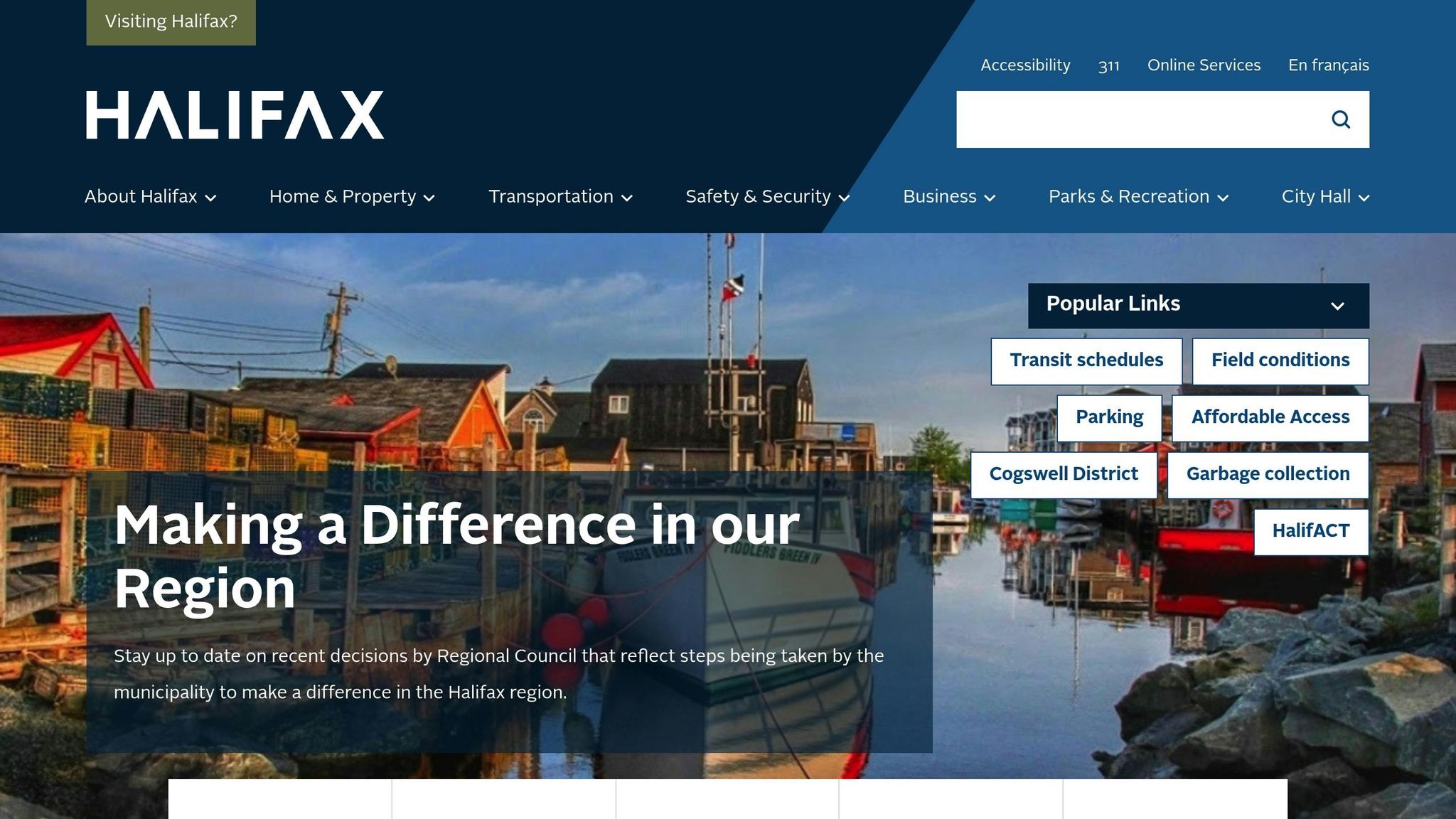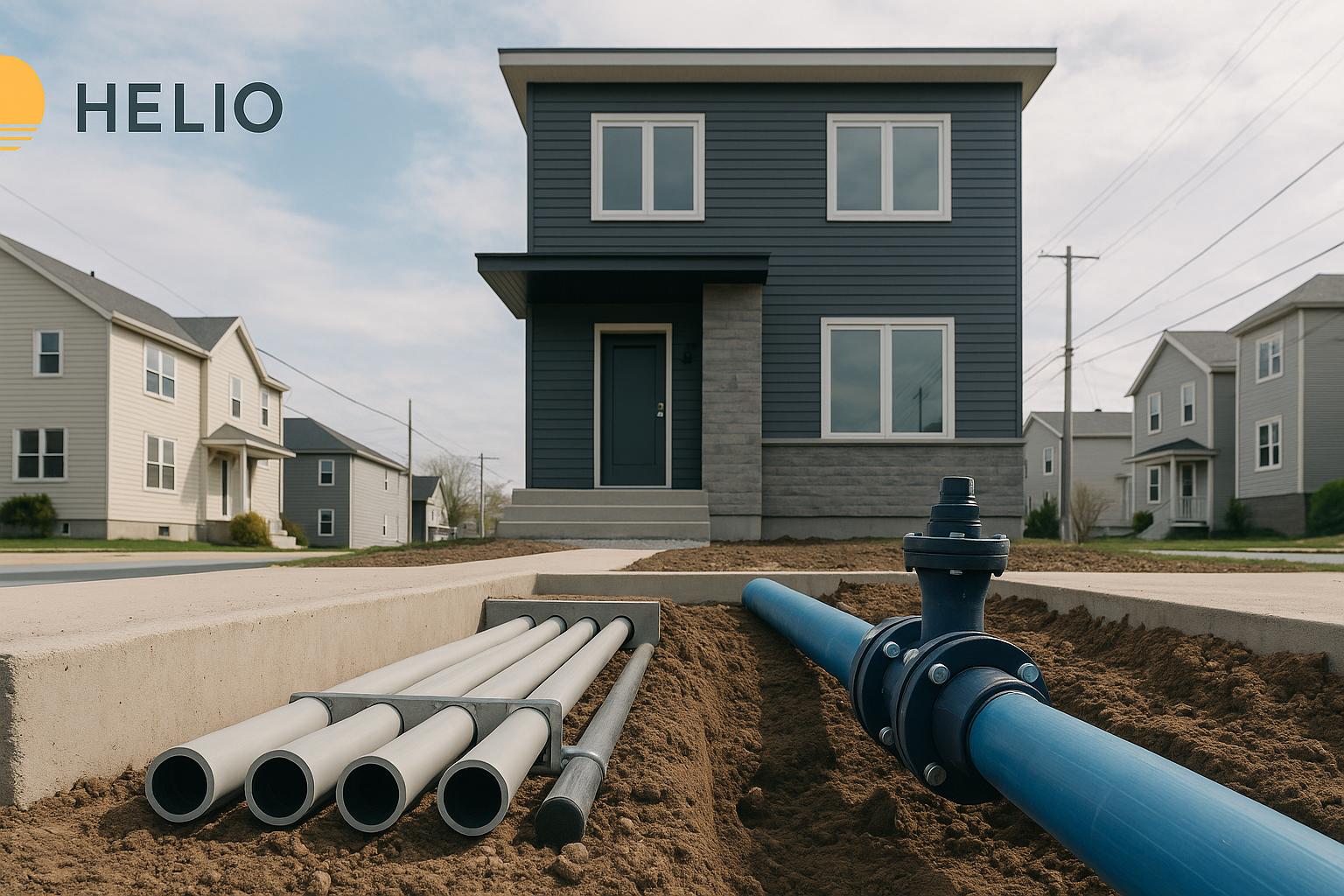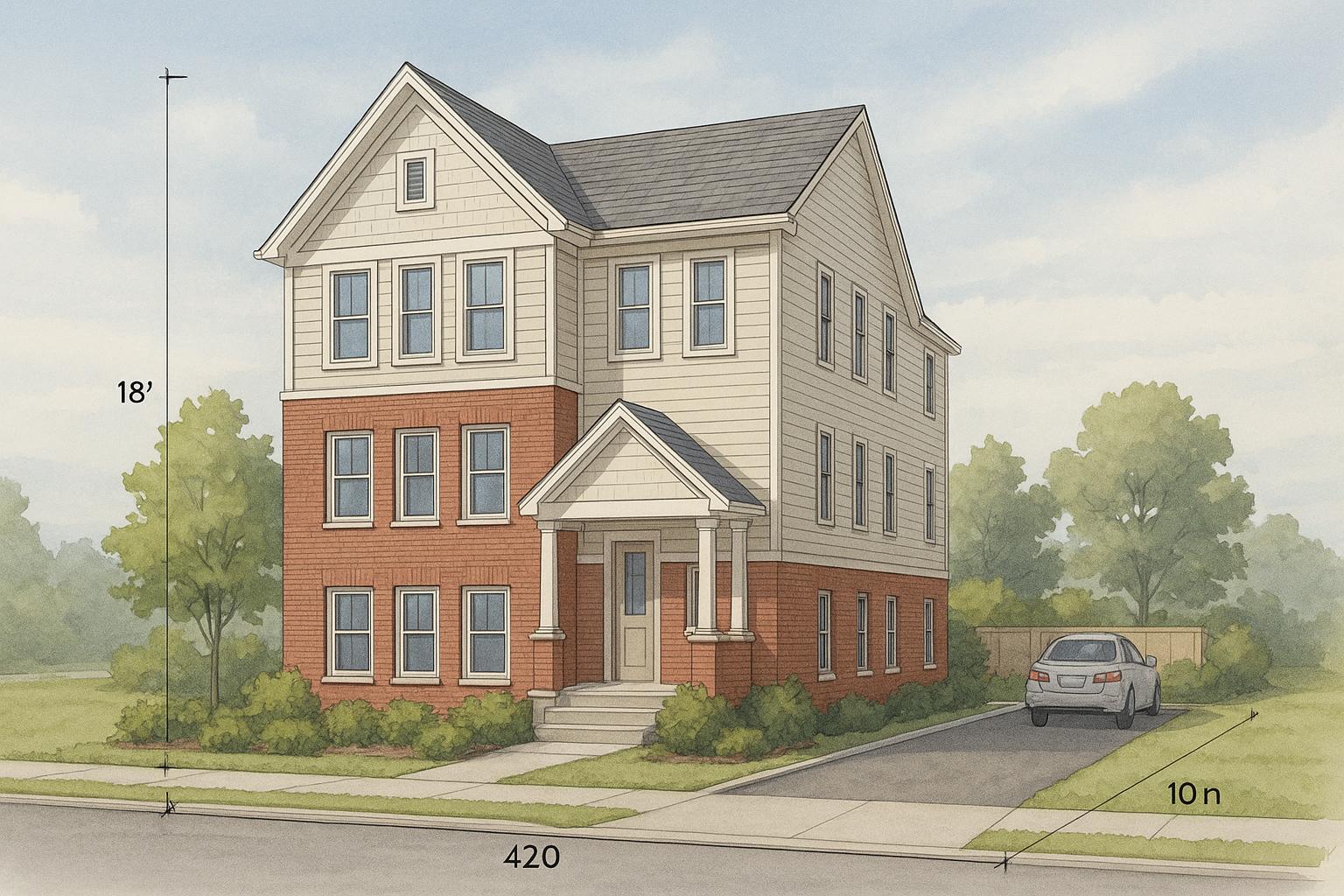When planning a 4–24 unit rental property in Halifax Regional Municipality (HRM), your choice between the Architect + GC model and Design-Build directly impacts how quickly you secure permits and start earning rental income. Delays in HRM’s permitting process can stretch from 6 months to over 18 months, costing you thousands in lost revenue and increased financing costs. Here’s a quick breakdown:
- Architect + GC: Separate teams for design and construction often lead to miscommunication, revisions, and delays. Permit approvals can take longer due to fragmented coordination and reactive problem-solving.
- Design-Build: Combines design and construction under one team, ensuring better coordination, fewer revisions, and faster permit approvals. This integrated approach aligns all professionals from the start, minimizing delays.
Key Takeaway: Design-Build is the faster, more predictable option for HRM permits, helping you avoid costly delays and start earning rental income sooner.
Quick Comparison
| Factor | Architect + GC Model | Design-Build Model |
|---|---|---|
| Accountability | Divided among multiple parties | Single point of responsibility |
| Permit Timeline | 12–18 months typical | 6 months guaranteed |
| Revision Cycles | Frequent and time-consuming | Minimal due to upfront coordination |
| Cost Overruns | 30–60% above budget | Fixed pricing upfront |
| Communication | Disjointed between teams | Unified and streamlined |
| HRM Compliance | Reactive during review | Proactive during design |
For HRM property owners, Design-Build simplifies the process, reduces delays, and ensures faster approvals, making it the clear choice for multi-unit rental projects.
Design-Bid Build, Design-Build, and Architect-Led: Comparing Construction Methods
HRM Permitting Process Explained

Navigating HRM's permitting process can shed light on how an integrated design approach helps avoid the delays often faced by fragmented project teams. Following HRM's structured procedure is key to ensuring multi-unit projects launch on schedule.
Steps to Get Building Permits in HRM
To begin, HRM requires a primary Building Permit. Alongside this, additional permits - such as lot grading or deck permits - are often necessary. Each of these permits comes with its own review timeline. Missing a deadline for any one of these can push back the entire project, so staying on top of the schedule is critical.
HRM Requirements and Recent Updates
Securing the right permits is just one part of the process. Keeping track of HRM's updates is equally important for avoiding unexpected delays. Since December 15, 2020, all permit applications must be submitted through HRM's online Permitting, Planning, Licensing & Compliance (PPLC) system [1]. This platform is now the go-to resource for uploading documents and managing the approval process efficiently.
Architect + GC Model: Problems and Delays
When architects and general contractors operate independently, the process becomes fragmented, often leading to delays in Halifax Regional Municipality (HRM) permit approvals. This lack of coordination creates costly setbacks for property owners.
Coordination Problems and Common Delays
Miscommunication between architects and contractors frequently results in documents that fail to meet HRM's strict requirements. This forces revisions and repeated resubmissions, which can be both time-consuming and expensive. For instance, if structural drawings are created separately from mechanical plans, any inconsistencies can halt the HRM review process until the discrepancies are resolved. Each revision cycle can add weeks to the timeline, creating additional headaches for property owners.
A sequential workflow also delays the detection of issues, often pushing revisions to later stages of the process. This reactive method not only increases costs but also leaves property owners stuck between conflicting advice from different professionals. Meanwhile, the project remains stalled in HRM's review queue, further compounding delays.
Expected Permit Timelines for Architect + GC
With the traditional Architect + GC model, securing permit approval in HRM can take months, even under ideal conditions. After the initial submission, contractors often request design changes to address compliance or constructability concerns. These requests can trigger multiple rounds of revisions, especially when architectural and engineering documents don’t align. Each round extends the timeline, making it difficult for property owners to plan construction schedules or secure financing confidently.
These delays can also lead to higher carrying costs and missed income opportunities, such as rental revenue. This unpredictability highlights the need for a more streamlined approach, like the integrated Design-Build model, which significantly reduces these challenges.
Architect + GC vs Design-Build: Key Problems
| Issue | Architect + GC Model | Design-Build Model |
|---|---|---|
| Accountability | Divided among multiple parties | Single point of responsibility |
| Timeline Predictability | Uncertain, prone to delays | Guaranteed timelines with penalties |
| Revision Cycles | Frequent and time-consuming | Streamlined through integrated planning |
| Cost Overruns | Typically 30-60% above budget | Fixed pricing established upfront |
| Communication | Disjointed between teams | Seamless collaboration within one team |
| HRM Compliance | Reactive to issues during review | Proactive planning for code compliance |
The core issue with the Architect + GC model is its reactive nature. Instead of addressing HRM requirements upfront, problems arise during the review process, leading to prolonged timelines, higher professional fees, and inefficiencies that can add up to an average of $47,000 per project. In the next section, we’ll explore how the Design-Build model overcomes these obstacles.
sbb-itb-16b8a48
Design-Build Model: Faster Permits in HRM
When it comes to navigating the delays often associated with the traditional Architect + GC model, the Design-Build approach offers a faster and more dependable alternative. By bringing architects, engineers, and contractors together under one team, this method streamlines the process and speeds up permit approvals in Halifax Regional Municipality (HRM).
How Integration Speeds Up Permits
With the Design-Build model, a single team works collaboratively to meet HRM requirements from the outset. Architects create drawings with direct input from engineers and contractors, ensuring that structural, mechanical, and electrical systems are fully aligned before submission. This teamwork significantly reduces the back-and-forth revisions that are common when separate professionals work in isolation.
Early compliance checks are built into the process. Construction teams assess architectural plans for buildability while engineers verify they meet code requirements. This proactive approach resolves potential issues during the design phase, well before HRM begins its review.
A unified communication structure also simplifies interactions with HRM. Instead of dealing with multiple contacts, municipal staff can work with a single point of contact for any clarifications. Updates to architectural drawings automatically reflect across related plans, ensuring all submission documents remain consistent.
Design-Build Success Examples in HRM
Helio Urban Development, Nova Scotia's only integrated design-build company specializing in multi-unit rental properties, is a standout example of how this approach accelerates permitting in HRM. Currently, they have 31 units under construction and 131 more in the planning stages across the province. Their in-house team of planners, architects, and engineers ensures compliance with zoning bylaws, building codes, and municipal standards from the very beginning. This meticulous preparation is the foundation of their six-month construction guarantee.
Helio Urban's track record proves that integrated design and construction can significantly reduce permit delays in HRM. Their fixed-price construction, set at $160,000 per unit, includes built-in accountability measures, such as penalties of up to $1,000 per day if deadlines aren’t met. This level of transparency and responsibility is a key advantage of the Design-Build model.
Design-Build vs Architect + GC: Speed Comparison
| Factor | Design-Build Model | Architect + GC Model |
|---|---|---|
| Initial Submission Quality | Coordinated documents with fewer revisions | Inconsistencies requiring resubmission |
| Municipal Communication | Single point of contact | Multiple parties with conflicting information |
| Revision Timeline | Immediate cross-disciplinary coordination | Sequential reviews leading to extended cycles |
| Compliance Verification | During design phase | Reactive during municipal review |
| Construction Timeline | Six months guaranteed | 12–18 months typical |
| Budget Certainty | Fixed pricing with zero overruns | Cost increases of 30–60% |
| Accountability | Single company responsibility | Divided among multiple firms |
The time savings during HRM’s review process are striking. When municipal staff request clarifications or changes, a Design-Build team can respond immediately. In contrast, the traditional Architect + GC model often requires days or weeks to coordinate input from separate firms. This integrated approach also reduces risk. Instead of juggling relationships with multiple professionals, property owners work with a single company responsible for both permit approval and construction, avoiding the blame games that can arise with delays or budget overruns.
This model is especially beneficial for multi-unit properties, where even minor delays can have a big financial impact. For example, in a four-unit building with rents ranging from $1,950 to $2,100 per month per unit, a one-month delay could result in a loss of about $8,000 in rental income. Predictable timelines not only help owners plan their financing but also ensure they can start earning on schedule.
Actual Timelines and Tips for HRM Permits
The time it takes to get your permit approved can directly impact your project's start date and overall profitability. Delays in approvals can eat into your financial returns, making it crucial to plan carefully.
Timeline Comparison: Architect + GC vs Design-Build
When using the traditional Architect + GC model, the permit process often drags due to the back-and-forth between architects, engineers, and contractors. Each step is handled in sequence, which can lead to multiple revisions and slow responses to municipal feedback. On the other hand, the Design-Build approach brings planners, architects, and engineers together from the beginning. This collaboration typically results in well-coordinated documentation and quicker responses to municipal requests, ultimately speeding up the permit approval process. Here’s how you can further streamline your HRM approval timeline.
Tips for Faster HRM Permits
To avoid unnecessary delays and keep your project moving, consider these practical steps:
-
Submit Complete Documentation
Make sure your submission includes all required materials, such as architectural drawings, engineering plans, and site layouts. Well-prepared and coordinated documentation minimizes the chance of multiple revision cycles. -
Verify Zoning Early
Get feedback on zoning requirements like setbacks, building heights, and parking regulations early in the planning phase. This can help you avoid unexpected issues later in the process. -
Use HRM's Digital Submission System
When submitting online, double-check that your files meet HRM's formatting and naming guidelines. Properly organized submissions can speed up processing and make communication with reviewers more efficient. -
Maintain Clear Communication
Designate one person as your main contact with municipal staff. Teams that work in an integrated fashion, like those at Helio Urban Development, often benefit from streamlined communication, reducing the risk of delays caused by conflicting feedback. -
Plan for Accessibility and Energy Code Compliance
Familiarize yourself with Nova Scotia’s building code early in the design phase. For example, Helio Urban's CMHC MLI Select construction projects go beyond standard energy efficiency requirements, ensuring compliance with stricter regulations from the outset. -
Schedule Inspections Early
Coordinate inspection dates as part of your construction schedule. Early planning helps avoid delays after your permit is approved and keeps the project timeline on track.
These steps reinforce the idea that a well-coordinated, integrated approach can save time and reduce complications compared to traditional methods.
Conclusion: Which Method Works Better
The Design-Build model consistently outshines the traditional Architect + GC approach when it comes to securing HRM permit approvals. Why? Because integrated teams remove the coordination gaps that often slow down fragmented construction methods. This seamless collaboration eliminates the delays caused by separate teams waiting on each other.
With Design-Build, you get single-source accountability - one unified team managing everything from design to municipal responses. This cuts out the inefficiencies of disconnected disciplines and ensures faster progress.
For multi-unit rental properties, this approach can shave weeks off permit timelines. Integrated teams provide better documentation, respond more quickly to municipal requests, and maintain clear communication throughout the process. This efficiency translates into earlier rent collection, which is a major financial win for property owners. Every month of delay means thousands of dollars in lost rental income, making the choice of construction method a critical financial decision.
Key Takeaways for Property Owners
If you're planning a multi-unit rental project in HRM, here are some crucial points to keep in mind when deciding on your construction approach:
- Speed is money. For example, a four-unit building renting at $1,950 per unit means every month of delay costs you $7,800 in potential income. The faster permits are secured, the sooner you can start earning.
- Fragmented teams slow things down. The traditional model’s back-and-forth between separate professionals leads to delays. When municipal staff request changes, these teams often take longer to respond and can create new conflicts.
- Single accountability simplifies the process. With Design-Build, there’s no finger-pointing or confusion over who handles what. One team manages municipal feedback and revisions from start to finish.
- Better documentation equals fewer delays. Integrated teams working together daily produce more accurate and coordinated drawings, minimizing revision cycles that can drag out municipal approvals.
Helio Urban Development provides a clear example of how this approach works in practice. By bringing planners, architects, engineers, and construction teams under one roof, they eliminate the inefficiencies that typically add weeks to permit timelines. With 31 units currently under construction and 131 more in the planning stages across Nova Scotia, their track record demonstrates the advantages of integration for property owners.
As highlighted earlier, choosing an integrated team ensures smoother communication and faster municipal approvals. For property owners eager to start earning rental income sooner, Design-Build is the clear path to quicker results in HRM.
FAQs
How does the Design-Build approach help keep projects on budget compared to the Architect + GC model?
The Design-Build method stands out for its ability to keep projects on budget by uniting the design and construction processes under one team. This streamlined approach ensures smoother coordination, fewer surprises, and a more efficient workflow. Decisions can be made quickly, and potential issues are addressed proactively, helping to avoid costly delays or unexpected expenses.
On the other hand, the Architect + General Contractor (GC) model often divides accountability, which can lead to miscommunication or complications when design changes arise - frequently resulting in budget overruns. With single-source responsibility, the Design-Build process significantly reduces the need for change orders and ensures the project stays on track financially from beginning to end.
How can property owners in HRM speed up permit approvals with the Design-Build approach?
To speed up permit approvals in HRM using the Design-Build approach, start with a pre-application consultation. This step helps confirm all requirements upfront, reducing the risk of unexpected issues during the review process. Make sure to submit complete and accurate documentation, including detailed building plans, to avoid delays caused by errors or missing information.
It’s also important to stay informed about local legislation designed to streamline housing approvals and ensure all required fees are paid promptly. The Design-Build model makes this process smoother by providing single-source accountability. With one team managing the entire project, coordination is more efficient, and common delays caused by miscommunication between separate parties are avoided.
How does single-source accountability in the Design-Build model speed up permits for property owners in HRM?
In the Design-Build model, single-source accountability means that one team manages both the design and construction phases. This approach simplifies communication and decision-making, cutting out the delays often caused by the back-and-forth between separate parties in the traditional Architect + General Contractor (GC) setup. With no separate contracts to juggle, there’s less room for miscommunication or blame-shifting.
For property owners in HRM, this streamlined approach translates to quicker permit approvals, more dependable timelines, and fewer conflicts. By consolidating responsibility under one team, the Design-Build model eliminates inefficiencies and creates a smoother, more straightforward process for getting your project off the ground.
Related Blog Posts
- Navigating Nova Scotia Building Permits and Approvals: A Step-by-Step Guide
- HR-1 (HR1) Stepbacks Next to ER - Oxford Street Edition
- Halifax Builder vs General Contractor: Who Handles Permits and SPA (Site Plan Approval)?
- HR-1 (HR1) Builder Halifax: Elevators, Egress, and the Breakpoints That Change Plans



